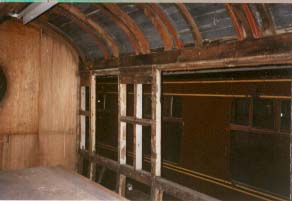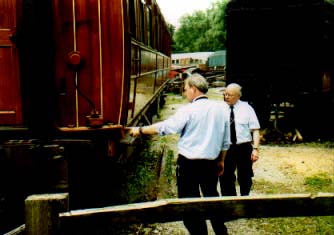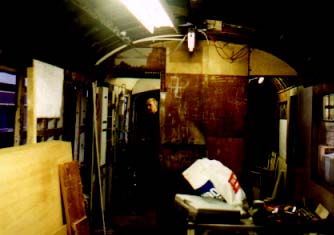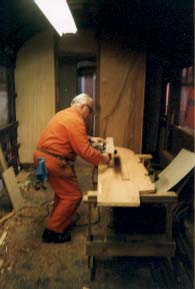
Before we start the story, I would like to appeal to anyone out there who is within range of Bo'ness and has any sort of practical skill which might help the restoration process speed up. We need you! Come along any Tuesday, Thursday or Sunday to the RCB building at Bo'ness - you will be welcomed with open arms to this very deserving cause!
 North-east corner of the saloon, Spring 1999
North-east corner of the saloon, Spring 1999
In 1996 and up to 1999 all the outer panelling was removed and all of the internal trim. Rotten framing and structural components was replaced as required. The electrical wiring was all being upgraded to comply with fire regulations so that replacement of the ceiling and reconstruction of the interior could begin. Apart from the framing, and the roof boarding, virtually everything inside the coach had to be re-built. The intention is to restore the coach to as near 1937 condition as possible rather than 50's & 60's version for which BR was responsible.
The railtour which went to York in the summer of 1999 carried a possie which went on to Pickering to visit buffet 641 in traffic on the NYMR. The coach was boarded at Pickering, then photographed and measured feverishly until we had to change trains at Levisham for the trip back to Pickering. A lot of useful information was gleaned from the very helpful staff on the train. We then returned to York to catch the returning railtour to Scotland. The picture shows Ronnie and Dave Simpson inspecting another Gresley restoration (enviously?).


Inspecting the "opposition" at Pickering Summer 1999 West (kitchen) end of the coach, Summer 1999
This view was taken before the boiler was re-instated.
The late (and greatly missed) Alec Smyth is the man
hiding in the kitchen.
Rotten external panelling was removed and all the rusted knee irons taken out after the vertical tie rods were
pulled. Some roof boards were removed on the North side to allow the rods to be pulled from above (and replaced). Temporary
mains lighting was rigged up inside the coach. The non-kitchen end vestibule partition has been repaired and the panelling
within the vestibule either stripped out or taken back to the original teak.
The
overhead wiring for lights, fans and the PA has been put in place so that work on replacing the many missing roof "ribs"
can proceed. There are many of these missing, and they all have to be made from solid timber cut to the correct profile
then glued together and finally fitted in place screwed to the roof boards. Behind the bar the lighting and fan controls
have been sighted as has the PA. These items are hidden just inside the kitchen behind the central bulkhead.
One of the more difficult (physical) jobs was lifting the old flooring and tiles. The tiles were glued to plywood which was
in turn glued to the floorboards as well as being screwed down at 3 inch intervals in both directions! New ribs have been
installed on the south side of the coach to correct the bulge in the profile. This project was masterminded by Ronnie
and involved jacking the body to the correct profile before screwing new ribs in to keep the new shape.
A set of batteries has been installed along with a built in charger for use while the coach is mains wired (for
lighting) during reconstruction. The coach now has a transmit and a receive PA installed with speakers mounted along
the centre line of the roof.
While re-wiring the kitchen overhead lights and removing the corridor water storage tank, it was discovered that the
kitchen/corridor wall was rotten. The problem was caused by a leak above the corridor water tank only seen after the
tank was removed. A large part of the kitchen wall had to be removed. The kitchen ceiling has also been removed
to allow replacement of roof board bolts. The original screws used to secure the boarding to the metal hoops are
largely rusted allowing the boards to "spring" in numerous places throughout the coach. 200 of these screws
have been replaced by bolts so far - only about another 1000 to go! Alec and Stuart have spent many (happy?) hours,
one on the roof, the other on a pair of steps inside the saloon replacing these screws with coach bolts.
All of the looses ceiling trimmers have been properly fixed and new ones are being made to get the ceiling profile back to
the original shape.

Ronnie working on the vestibule partition, April 1999
All of the knee irons on the south side have now been replaced and the tie rods put back into place. Ronnie devised a way of doing this which did not involve either removing roof boards or digging pits beside the track. The technique is to grease the channel in the wood rib, then thread the rod in from above starting at the waist rail. When the rod is in far enough down to be below the cant rail, it is then pushed inwards and back up through the cant rail. New knee irons on the north side have now being fitted. These have to be bolted in before the tie rods can be threaded into position.
The old bar counter has been stripped out and a new base for the boiler put in place. Most of the old kitchen furniture has also been stripped out. The plumbing for the boiler is being installed currently by Robin and Don. The boiler used to be supplied with water from the corridor tank, but its removal has meant re-routing of the supply under the coach. The tank above the vestibule ceiling will now provide all the water needs of the coach. The gas boiler has now been hydraulically tested - the next step is firing it up to see if it is still leak-proof at high temperature.
The kitchen has been stripped out so that modern kitchen equipment can be installed. The kitchen/saloon partition thickness
has been halved to allow refitting of the sliding door to access behind the counter. New ceiling trunking is being installed
to take the RCH, extractor fan and lighting wiring. The current plan is to re-install light fittings at the original positions,
but to supplement the lighting with a pair of 4 foot fluorescent fittings. The reason for this is to concerve battery power:
if the five original fittings were fitted with 60w bulbs the total consumption would be 300w. The same (or better) level of
illumination can be obtained from 2 x 40w of fluorescent tubes.
The partition between the kitchen and the corridor was rotten at the saloon end so it has been completely removed. The
(BR) door into the corridor was not opposite the exterior doors so the partition would have needed major modifications
anyway.
For your interest, the LNER Coach Association based at Pickering on the North Yorks Moors Railway has restored its Gresley Buffet no. 641 (built 1937) to "original" condition. The restoration project team is indebted to Andrew Daniel for all the help and invaluable information he has given us. (Andrew was deeply involved in the restoration of 641.)